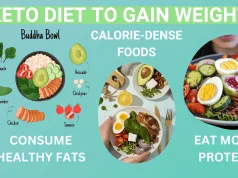How to be on a low carb diet is a question many people ask, seeking to improve their health and well-being. This dietary approach focuses on reducing carbohydrate intake, emphasizing protein, healthy fats, and non-starchy vegetables. Low-carb diets, like the ketogenic, Atkins, and South Beach, have gained popularity for their potential benefits, including weight loss, improved blood sugar control, and enhanced energy levels. However, it’s important to understand the potential risks and side effects associated with any dietary change, and to consult with a healthcare professional before embarking on a low-carb journey.
This guide will delve into the fundamentals of low-carb dieting, exploring its benefits, potential risks, and practical tips for success. We’ll discuss how to plan your meals, create a grocery list, and navigate the transition period, providing you with the information and support you need to make informed decisions about your health.
Understanding the Low-Carb Diet
A low-carb diet restricts carbohydrates, focusing on protein and healthy fats. This approach aims to reduce insulin levels, promote fat burning, and potentially lead to weight loss. However, it’s crucial to understand the principles, types, and implications of low-carb diets before adopting them.
Types of Low-Carb Diets
Low-carb diets come in various forms, each with specific guidelines and approaches. Understanding these differences can help you choose the most suitable option.
- Ketogenic Diet: The ketogenic diet is a very low-carb, high-fat diet that forces the body into a metabolic state called ketosis. In ketosis, the body primarily burns fat for energy instead of carbohydrates. This diet typically restricts carbohydrates to 20-50 grams per day, with a high intake of healthy fats and moderate protein.
- Atkins Diet: The Atkins diet is a popular low-carb approach with four phases. It starts with a very strict induction phase, limiting carbohydrates to 20 grams per day. As weight loss progresses, the diet gradually introduces more carbohydrates. The Atkins diet emphasizes protein and healthy fats while limiting sugary foods, processed grains, and starchy vegetables.
- South Beach Diet: The South Beach diet focuses on reducing refined carbohydrates and sugars while promoting whole grains, lean proteins, and healthy fats. It emphasizes a balanced approach to low-carb eating, emphasizing good food choices and portion control. This diet allows for a wider range of carbohydrates than the ketogenic or Atkins diets.
Foods to Include and Exclude
The core principle of a low-carb diet is to reduce carbohydrate intake while focusing on protein and healthy fats. Here’s a breakdown of foods to include and exclude:
- Foods to Include:
- Protein: Meat, poultry, fish, eggs, dairy (depending on the specific diet), and protein powders.
- Healthy Fats: Olive oil, avocado oil, coconut oil, nuts, seeds, and fatty fish like salmon and tuna.
- Low-Carb Vegetables: Broccoli, cauliflower, spinach, kale, Brussels sprouts, asparagus, and green beans.
- Foods to Exclude:
- Sugary Foods: Candy, soda, pastries, and desserts.
- Starchy Foods: Bread, pasta, rice, potatoes, and corn.
- Processed Foods: Packaged snacks, processed meats, and fast food.
Benefits of a Low-Carb Diet: How To Be On A Low Carb Diet
A low-carb diet, characterized by restricting carbohydrate intake while emphasizing protein and healthy fats, has gained popularity for its potential health benefits. While the long-term effects are still under investigation, numerous studies suggest that a low-carb approach can be beneficial for weight management, blood sugar control, and overall health.
Weight Loss
Low-carb diets can be effective for weight loss by promoting a feeling of fullness and reducing overall calorie intake. Carbohydrates, particularly refined and processed ones, are quickly digested and can lead to rapid blood sugar spikes followed by crashes, triggering cravings and overeating. By reducing carbohydrate consumption, individuals may experience fewer cravings, eat less, and ultimately lose weight.
Improved Blood Sugar Control
Low-carb diets can significantly improve blood sugar control, particularly for individuals with type 2 diabetes or prediabetes. By limiting carbohydrate intake, the body relies more on fat for energy, leading to reduced insulin resistance and better blood sugar regulation. This can help prevent complications associated with uncontrolled blood sugar levels, such as heart disease, nerve damage, and kidney disease.
Reduced Risk of Heart Disease
Low-carb diets have been linked to reduced risk factors for heart disease, including lower blood pressure, improved cholesterol levels, and reduced inflammation. By limiting refined carbohydrates and processed foods, individuals may consume fewer unhealthy fats and sugars, leading to a healthier cardiovascular profile.
Potential Risks and Side Effects
While low-carb diets offer potential benefits, it is essential to be aware of potential risks and side effects. Some individuals may experience initial side effects, such as fatigue, headaches, and constipation, known as the “keto flu.” These symptoms are usually temporary and subside as the body adapts to the dietary change.
- Nutrient Deficiencies: Restricting carbohydrates can limit the intake of essential nutrients found in whole grains, fruits, and vegetables, such as fiber, vitamins, and minerals. It is crucial to ensure adequate intake of these nutrients through other sources or supplementation.
- Kidney Stones: Some studies suggest that low-carb diets may increase the risk of kidney stones, particularly in individuals with a predisposition to stone formation. It is essential to stay adequately hydrated and consult with a healthcare professional if you have a history of kidney stones.
- Long-Term Effects: The long-term effects of low-carb diets are still being studied, and more research is needed to fully understand their potential benefits and risks. While some studies suggest that low-carb diets can lead to improved metabolic health and reduced risk of chronic diseases, others raise concerns about the long-term sustainability and potential negative effects on bone health and nutrient intake. It is crucial to consult with a healthcare professional to determine if a low-carb diet is suitable for you and to monitor your health regularly.
Planning Your Low-Carb Diet

Planning a low-carb diet requires careful consideration of your food choices and portion sizes. You need to ensure you’re getting the necessary nutrients while keeping your carbohydrate intake low.
Sample Low-Carb Meal Plan
Here’s a sample low-carb meal plan for a day:
Breakfast
* Scrambled eggs with spinach and cheese: This provides protein and healthy fats.
* Greek yogurt with berries and nuts: Greek yogurt is a good source of protein and probiotics, while berries and nuts offer antioxidants and healthy fats.
Lunch
* Tuna salad with lettuce wraps: Tuna is a lean protein source, and lettuce wraps provide fiber and low carbs.
* Chicken breast salad with mixed greens and avocado: Chicken breast is another lean protein, and avocado adds healthy fats.
Dinner
* Salmon with roasted vegetables: Salmon is rich in omega-3 fatty acids, and roasted vegetables provide vitamins and minerals.
* Beef stir-fry with cauliflower rice: Beef provides protein, and cauliflower rice is a low-carb alternative to regular rice.
Low-Carb Recipes, How to be on a low carb diet
Here are some low-carb recipes for breakfast, lunch, and dinner:
Breakfast
* Keto Pancakes: These pancakes are made with almond flour and coconut flour, making them low in carbs and high in protein.
* Egg Muffins: These muffins are a great way to get a quick and easy breakfast on the go. They’re filled with eggs, cheese, and vegetables.
Lunch
* Chicken Caesar Salad: This classic salad is made with romaine lettuce, grilled chicken, parmesan cheese, and a creamy Caesar dressing.
* Zucchini Noodles with Pesto: Zucchini noodles are a great low-carb alternative to pasta. They’re tossed with a delicious pesto sauce.
Dinner
* Shepherd’s Pie with Cauliflower Mash: This classic dish is made with ground beef, vegetables, and a creamy cauliflower mash.
* Chicken Fajitas with Bell Peppers and Onions: These fajitas are made with chicken, bell peppers, and onions. They’re served with low-carb tortillas or lettuce wraps.
Low-Carb Grocery List
Here’s a grocery list for a low-carb diet:
* Meat: Beef, chicken, turkey, fish, pork, lamb
* Seafood: Salmon, tuna, shrimp, crab
* Eggs: Whole eggs
* Dairy: Cheese, Greek yogurt, cottage cheese
* Vegetables: Broccoli, cauliflower, spinach, kale, Brussels sprouts, asparagus, green beans, bell peppers, onions, mushrooms
* Fruits: Berries, avocado
* Nuts and Seeds: Almonds, walnuts, pecans, chia seeds, flax seeds
* Low-Carb Flours: Almond flour, coconut flour
* Spices and Herbs: Salt, pepper, garlic powder, onion powder, paprika, cumin, oregano, basil
Tips for Success on a Low-Carb Diet
Embarking on a low-carb diet can be a rewarding journey, but it also requires commitment and strategies to overcome potential challenges. Here are some tips to help you navigate the transition and achieve sustainable success.
Overcoming Cravings and Hunger
Managing cravings and hunger is a common concern for those transitioning to a low-carb lifestyle. It’s important to address these challenges head-on with a combination of strategies.
- Prioritize Protein and Healthy Fats: Including protein and healthy fats in every meal helps you feel fuller for longer, reducing cravings and hunger pangs. Examples of protein sources include lean meats, fish, poultry, eggs, and dairy products. Healthy fats like avocado, olive oil, and nuts provide sustained energy and satiety.
- Stay Hydrated: Sometimes thirst can be mistaken for hunger. Drinking plenty of water throughout the day can help regulate your appetite and prevent dehydration.
- Mindful Eating: Pay attention to your hunger cues and eat slowly, savoring each bite. This allows your body to register fullness and helps prevent overeating.
- Plan Your Meals and Snacks: Having a plan for your meals and snacks can help prevent impulsive choices when cravings strike. Prepare low-carb meals in advance or have healthy snacks readily available.
- Identify Triggers: Become aware of your personal triggers for cravings, such as stress, boredom, or social situations. Develop healthy coping mechanisms to manage these triggers.
Staying Motivated and Consistent
Sustaining a low-carb lifestyle requires a long-term commitment. Maintaining motivation and consistency is crucial for achieving your goals.
- Set Realistic Goals: Avoid drastic changes that can be overwhelming. Start with small, achievable goals and gradually increase the intensity of your low-carb approach.
- Find Support: Connect with others who follow a low-carb diet or join online communities for support and encouragement. Sharing experiences and challenges can help you stay motivated.
- Track Your Progress: Keep a food journal or use a tracking app to monitor your progress and identify areas for improvement. Seeing your achievements can boost your motivation.
- Reward Yourself: Celebrate your successes along the way. Reward yourself with non-food-related treats or activities that you enjoy.
- Focus on the Benefits: Remember the reasons why you embarked on a low-carb diet. Focus on the positive health outcomes and lifestyle improvements you’re experiencing.
Incorporating Physical Activity
Physical activity complements a low-carb diet by enhancing weight management, improving overall health, and boosting energy levels.
- Choose Activities You Enjoy: Select activities that you find enjoyable and sustainable in the long term. This increases the likelihood of adherence.
- Start Gradually: Begin with moderate-intensity exercise and gradually increase the duration and intensity as your fitness level improves.
- Listen to Your Body: Pay attention to your body’s signals and rest when needed. Overtraining can lead to fatigue and setbacks.
- Seek Professional Guidance: Consult with a healthcare professional or certified personal trainer to create a safe and effective exercise plan tailored to your individual needs.
Transitioning to a Low-Carb Diet
Starting a low-carb diet can feel overwhelming, especially if you’re used to a high-carb lifestyle. The key is to make gradual changes to your eating habits to minimize potential side effects and maximize your chances of success.
Gradually Reducing Carbs
It’s best to start by gradually reducing your carbohydrate intake rather than making drastic changes overnight. This approach allows your body to adapt to the new way of eating. You can start by making small substitutions, like replacing sugary drinks with water or unsweetened tea. You can also gradually decrease the amount of starchy foods like potatoes, rice, and bread you eat.
Managing Potential Side Effects
During the transition to a low-carb diet, you may experience some side effects, commonly referred to as the “keto flu.” These side effects are usually temporary and typically subside within a few days.
Common Side Effects
- Headaches: Headaches are common during the initial phase of a low-carb diet due to changes in your body’s fluid balance and electrolyte levels.
- Fatigue: As your body adjusts to using fat as its primary energy source, you may experience fatigue or low energy levels.
- Muscle Cramps: Muscle cramps can occur due to electrolyte imbalances, especially low levels of sodium, potassium, and magnesium.
- Constipation: Some people experience constipation due to the reduced intake of fiber from high-fiber carbohydrates like fruits and vegetables.
- Bad Breath: A temporary change in your breath, often described as having a metallic or fruity odor, can be caused by the breakdown of fat for energy, which produces ketones.
Managing Side Effects
- Hydrate: Drink plenty of water throughout the day to help prevent headaches and fatigue.
- Electrolyte Support: Consider taking an electrolyte supplement or adding more electrolytes to your diet through foods like coconut water, bone broth, and leafy greens.
- Gradual Changes: Continue to make gradual reductions in your carbohydrate intake, allowing your body time to adjust.
- Fiber Intake: Ensure you are consuming adequate fiber from low-carb sources like vegetables, nuts, and seeds.
- Patience: Remember that the transition period is temporary. As your body adapts, the side effects will diminish.
Consulting a Healthcare Professional
It’s important to consult with a healthcare professional before starting any new diet, including a low-carb diet. This is especially important if you have any underlying health conditions or are taking medications. A healthcare professional can help you determine if a low-carb diet is appropriate for you and can provide personalized guidance and support.
Closing Notes
Embarking on a low-carb diet can be a transformative experience, offering the potential for improved health and well-being. By understanding the principles, benefits, and potential risks, and by carefully planning your meals and managing your expectations, you can embark on a journey towards a healthier lifestyle. Remember, consistency is key, and seeking guidance from a healthcare professional can help ensure you’re making the right choices for your individual needs.
FAQs
What are some common side effects of a low-carb diet?
Common side effects of a low-carb diet include headaches, fatigue, constipation, and bad breath. These symptoms are often temporary and tend to subside as your body adjusts to the dietary change.
How long should I stay on a low-carb diet?
The duration of a low-carb diet varies depending on individual goals and preferences. Some individuals may choose to follow a low-carb diet for a specific period to achieve weight loss, while others may adopt it as a long-term lifestyle change. It’s essential to consult with a healthcare professional to determine the appropriate duration for your specific needs.
Can I exercise while on a low-carb diet?
Yes, exercise is highly encouraged while on a low-carb diet. Physical activity can enhance weight loss, improve energy levels, and support overall health. However, it’s important to listen to your body and adjust your exercise intensity as needed.
A low-carb diet can be challenging, especially when you’re breastfeeding. It’s important to ensure you’re getting enough nutrients for both you and your baby. If you’re considering a low-carb approach while breastfeeding, it’s essential to consult with your doctor or a registered dietitian to learn about the best diet when breastfeeding.
They can help you create a balanced plan that meets your individual needs and ensures you’re getting the necessary nutrients for a healthy pregnancy and lactation.
Sticking to a low-carb diet can be challenging, especially when you’re trying to maintain a healthy weight. While it’s important to reduce carbohydrate intake, it’s equally crucial to ensure you’re getting enough calories for your body’s needs. If you’re looking to gain weight, you might want to consider exploring different strategies, such as following a best diet to gain weight plan.
However, remember that a low-carb diet should be tailored to your individual needs and goals, and it’s always best to consult with a healthcare professional before making any significant dietary changes.
Sticking to a low-carb diet means making mindful choices about what you consume. One common question that arises is whether or not you can enjoy diet soda, as it’s often considered a sugar-free option. To find out if it aligns with your keto goals, check out this article: can you drink diet soda on keto.
Ultimately, understanding how artificial sweeteners impact your body and your diet is crucial for successful low-carb living.
























